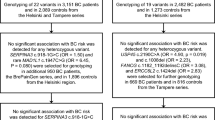Abstract
KLLN is a p53 target gene with DNA binding function and represents a highly plausible candidate breast cancer predisposition gene. We screened for predisposing variants in 860 high-risk breast cancer families using high resolution melt analysis. A germline c.339_340delAG variant predicted to cause premature termination of the protein after 57 alternative amino acid residues was identified in 3/860 families who tested negative for BRCA1 and BRCA2 mutations and in 1/84 sporadic breast cancer cases. However, the variant was also detected in 2/182 families with known BRCA1 or BRCA2 mutations and in 2/464 non-cancer controls. Furthermore, loss of the mutant allele was detected in 2/2 breast tumors. Our data suggest that pathogenic mutations in KLLN are rare in breast cancer families and the c.339_340delAG variant does not represent a high-penetrance breast cancer risk allele.

Similar content being viewed by others
References
Mann GJ, Thorne H, Balleine RL, Butow PN, Clarke CL, Edkins E, Evans GM, Fereday S, Haan E, Gattas M, Giles GG, Goldblatt J, Hopper JL, Kirk J, Leary JA, Lindeman G, Niedermayr E, Phillips KA, Picken S, Pupo GM, Saunders C, Scott CL, Spurdle AB, Suthers G, Tucker K, Chenevix-Trench G (2006) Analysis of cancer risk and BRCA1 and BRCA2 mutation prevalence in the kConFab familial breast cancer resource. Breast Cancer Res 8(1):R12. doi:10.1186/bcr1377
Cho YJ, Liang P (2008) Killin is a p53-regulated nuclear inhibitor of DNA synthesis. Proc Natl Acad Sci USA 105(14):5396–5401. doi:10.1073/pnas.0705410105
Bennett KL, Mester J, Eng C (2010) Germline epigenetic regulation of KILLIN in Cowden and Cowden-like syndrome. JAMA 304(24):2724–2731. doi:10.1001/jama.2010.1877
Eccles DM, Englefield P, Soulby MA, Campbell IG (1998) BRCA1 mutations in southern England. Br J Cancer 77:2199–2203
Bryan EJ, Watson RH, Davis M, Hitchcock A, Foulkes WD, Campbell IG (1996) Localization of an ovarian cancer tumor suppressor gene to a 0.5-cM region between D22S284 and CYP2D, on chromosome 22q. Cancer Res 56(4):719–721
Baxter SW, Choong DY, Eccles DM, Campbell IG (2001) Polymorphic variation in CYP19 and the risk of breast cancer. Carcinogenesis 22(2):347–349
Rozen S, Skaletsky H (2000) Primer3 on the WWW for general users and for biologist programmers. Methods Mol Biol 132:365–386
Gorringe KL, Choong DY, Williams LH, Ramakrishna M, Sridhar A, Qiu W, Bearfoot JL, Campbell IG (2008) Mutation and methylation analysis of the chromodomain-helicase-DNA binding 5 gene in ovarian cancer. Neoplasia 10(11):1253–1258
Jacobs S, Thompson ER, Nannya Y, Yamamoto G, Pillai R, Ogawa S, Bailey DK, Campbell IG (2007) Genome-wide, high-resolution detection of copy number, loss of heterozygosity, and genotypes from formalin-fixed, paraffin-embedded tumor tissue using microarrays. Cancer Res 67(6):2544–2551. doi:10.1158/0008-5472.CAN-06-3597
Knudson AG Jr (1971) Mutation and cancer: statistical study of retinoblastoma. Proc Natl Acad Sci USA 68(4):820–823
Cavenee WK, Hansen MF, Nordenskjold M, Kock E, Maumenee I, Squire JA, Phillips RA, Gallie BL (1985) Genetic origin of mutations predisposing to retinoblastoma. Science 228(4698):501–503
Ng PC, Henikoff S (2001) Predicting deleterious amino acid substitutions. Genome Res 11(5):863–874. doi:10.1101/gr.176601
Adzhubei IA, Schmidt S, Peshkin L, Ramensky VE, Gerasimova A, Bork P, Kondrashov AS, Sunyaev SR (2010) A method and server for predicting damaging missense mutations. Nat Methods 7(4):248–249. doi:10.1038/nmeth0410-248
Li B, Krishnan VG, Mort ME, Xin F, Kamati KK, Cooper DN, Mooney SD, Radivojac P (2009) Automated inference of molecular mechanisms of disease from amino acid substitutions. Bioinformatics 25(21):2744–2750. doi:10.1093/bioinformatics/btp528
Ferrer-Costa C, Gelpi JL, Zamakola L, Parraga I, de la Cruz X, Orozco M (2005) PMUT: a web-based tool for the annotation of pathological mutations on proteins. Bioinformatics 21(14):3176–3178
Schwarz JM, Rodelsperger C, Schuelke M, Seelow D (2010) MutationTaster evaluates disease-causing potential of sequence alterations. Nat Methods 7(8):575–576. doi:10.1038/nmeth0810-575
Bromberg Y, Rost B (2007) SNAP: predict effect of non-synonymous polymorphisms on function. Nucleic Acids Res 35(11):3823–3835. doi:10.1093/nar/gkm238
The 1000 Genomes Project Consortium (2010) A map of human genome variation from population-scale sequencing. Nature 467(7319):1061–1073. doi:10.1038/nature09534
Haga H, Yamada R, Ohnishi Y, Nakamura Y, Tanaka T (2002) Gene-based SNP discovery as part of the Japanese Millennium Genome Project: identification of 190,562 genetic variations in the human genome. Single-nucleotide polymorphism. J Hum Genet 47(11):605–610. doi:10.1007/s100380200092
Acknowledgments
This work was supported by the Victorian Breast Cancer Research Consortium.
Conflicts of interest
The authors declare no conflicts of interest.
Author information
Authors and Affiliations
Consortia
Corresponding author
Additional information
IGC and GM conceived of the study; ERT and DYHC carried out experiments and analyzed data; KLG interpreted data and generated the figure; IGC, KLG, and ERT were involved in writing the paper. All authors had final approval of the submitted and published versions.
Rights and permissions
About this article
Cite this article
Thompson, E.R., Gorringe, K.L., Choong, D.Y.H. et al. Analysis of KLLN as a high-penetrance breast cancer predisposition gene. Breast Cancer Res Treat 134, 543–547 (2012). https://doi.org/10.1007/s10549-012-2088-3
Received:
Accepted:
Published:
Issue Date:
DOI: https://doi.org/10.1007/s10549-012-2088-3




